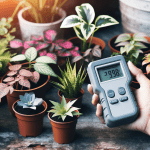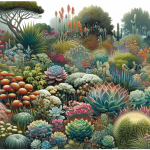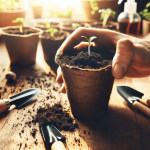This post may contain affiliate links. As an Amazon Associate, we may earn commissions from qualifying purchases.
Overwatering or underwateringAre your plants looking a bit under the weather? It’s possible that you may be giving them too much or too little water. But how can you tell? In this article, we’ll explore the signs of both overwatering and underwatering, so you can better understand what your plants are trying to tell you. From drooping leaves to yellowing foliage, we’ll delve into the subtle hints your plants give when they’re not getting enough or getting too much water. So, grab your watering can and join us as we decipher the secret language of plants!
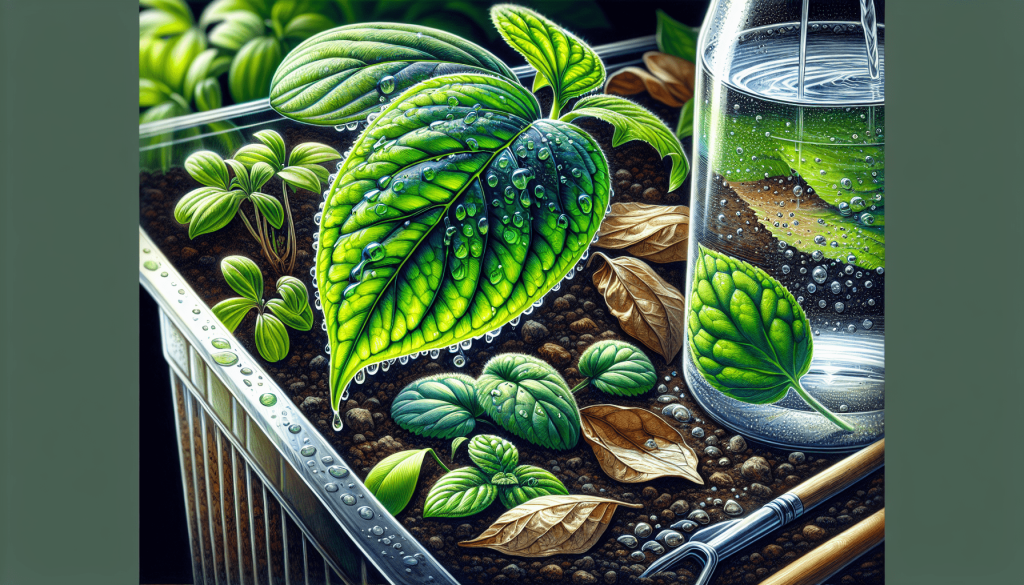
Signs of Overwatering
Yellowing of Leaves
One of the most common signs of overwatering is yellowing of the leaves. When plants receive too much water, their roots become waterlogged, leading to a lack of oxygen. This lack of oxygen prevents the roots from absorbing essential nutrients, resulting in the yellowing of leaves. If you notice that the lower leaves of your plant are turning yellow and eventually falling off, it may be a sign of overwatering.
Wilting Leaves
While wilting leaves are often associated with underwatering, overwatering can also cause this symptom. When plants are overwatered, their roots have difficulty absorbing water properly. As a result, the cells in the leaves become swollen and burst, leading to wilting. If you notice that your plant’s leaves are constantly drooping, even though the soil is moist, overwatering might be the culprit.
Root Rot
Root rot is a serious condition that occurs when plants are overwatered for an extended period. Overwatering creates a damp environment that promotes the growth of harmful bacteria and fungi. These pathogens attack the roots, causing them to decay and turning them mushy and brown. As a result, the plant’s ability to absorb water and nutrients is severely compromised. If you notice a foul odor or see black, mushy roots when inspecting the plant’s root system, it is likely suffering from root rot due to overwatering.
Fungus Gnats
Fungus gnats are small, flying insects that are often seen hovering around overwatered plants. These pests thrive in moist soil and their presence can be a clear indication of overwatering. Fungus gnats lay their eggs in the damp soil, and their larvae feed on decaying organic matter, including the roots of plants. If you see tiny flies buzzing around your plants or notice small white worms in the soil, it’s important to address the overwatering issue to eliminate the pests and prevent further damage to your plants.
Mold or Mildew Growth
Overwatering can create an environment that is conducive to the growth of mold and mildew. Excess moisture on the leaves and in the soil provides a breeding ground for these fungal diseases. If you notice fuzzy white or gray patches on the leaves, stems, or soil surface, it is likely a result of overwatering. Mold and mildew can weaken the plant’s overall health and hinder its ability to photosynthesize, which can lead to stunted growth and reduced vitality.
Signs of Underwatering
Wilting Leaves
Wilting leaves are often the first visible sign of underwatering. When plants do not receive enough water, they are unable to maintain turgidity, causing their leaves to become limp and droopy. Underwatered plants may recover temporarily after watering, but if the soil remains consistently dry, wilting will persist.
Leaf Curling
If your plant’s leaves are curling inward, it may be a sign of underwatering. When water is scarce, plants curl their leaves in an attempt to reduce the surface area exposed to the sun and minimize water loss through transpiration. Curling leaves can also be an indication of the plant entering a state of dormancy to conserve energy and survive the dry conditions.
Dry and Crispy Leaves
Underwatered plants often exhibit dry and crispy leaves. As the plant struggles to extract sufficient moisture from the soil, the leaves lose water and become dehydrated. This results in a brittle texture and a tendency to break easily. Additionally, the edges of the leaves may turn brown or develop necrotic spots, further indicating a lack of water.
Slow Growth
Insufficient water supply hampers a plant’s metabolic processes, leading to slow growth. When a plant lacks water, it prioritizes its survival by diverting resources away from growth-related activities. As a result, the overall growth rate of the plant is reduced, and new leaves, stems, and flowers may take longer to develop.
Drooping Leaves
While wilting leaves can be a sign of both overwatering and underwatering, the pattern of drooping can differ. In the case of underwatering, the leaves tend to droop from the top downwards. This contrasts with overwatering, where the leaves generally droop from the bottom upwards. If you observe your plant’s leaves drooping from the top, it may require more water to rehydrate.
Factors Affecting Watering Needs
Plant Type
Different plant species have varying water requirements. Some plants naturally thrive in moist conditions, while others prefer drier environments. Understanding the specific needs of your plants is crucial in determining their watering regimen. Research the water preferences of each plant type to ensure they receive the appropriate amount of water.
Plant Size
The size of a plant impacts its water requirements. Larger plants typically have more extensive root systems that can access water from a larger volume of soil. Consequently, they may require more water to meet their needs. On the other hand, smaller plants have smaller root systems and may dry out more quickly. Adjust your watering routine based on the size of your plants to ensure their hydration needs are adequately met.
Temperature and Humidity
Hot temperatures and low humidity levels accelerate the rate of evaporation, causing plants to lose water more rapidly. In such conditions, plants may require more frequent watering to compensate for the increased water loss. Conversely, cooler temperatures and higher humidity reduce water evaporation and can lead to slower soil drying. Take into account the prevailing weather conditions when establishing a watering routine for your plants.
Soil Type
The type of soil that your plants are potted in significantly affects their watering needs. Well-draining soils, such as sandy or loamy soils, allow excess water to flow through easily, reducing the risk of waterlogging and root rot. In contrast, heavy clay soils retain water for longer periods, which can result in overwatering and oxygen deprivation for the roots. Adjust your watering techniques based on the specific moisture retention characteristics of the soil.
Pot Size
The size of the pot in which your plants are housed can also impact their watering needs. Larger pots hold more soil, which provides a larger reservoir of water for the plant’s roots. On the other hand, smaller pots have limited soil volume, which can dry out quickly and require more frequent watering. Consider the pot size when establishing your watering routine and choose a pot that is appropriate for the plant’s size and water requirements.
Watering Techniques
Check Soil Moisture
Checking the moisture level of the soil is essential to determine whether your plants need watering. Stick your finger about an inch into the soil, and if it feels dry at that depth, it’s time to water. If the soil feels moist, it’s best to hold off on watering until it dries out a bit more. Alternatively, you can invest in a moisture meter or probe, which provides a more accurate measurement of soil moisture.
Watering Frequency
Establishing a watering routine based on the specific needs of your plants is crucial. While some plants require regular watering, others prefer a drier soil between waterings. Research the watering requirements of your plants and create a schedule that aligns with their needs. Remember to adjust the frequency based on factors such as temperature, humidity, and the individual characteristics of each plant.
Watering Amount
The amount of water you provide to your plants plays a significant role in maintaining their health. Avoid overwatering by ensuring that water penetrates the soil and reaches the root zone without causing waterlogging. To achieve this, water your plants thoroughly until the excess moisture drains out of the bottom of the pot. It’s important to note that different plant types have varying water requirements, so adjust the watering amount accordingly.
Watering Technique
The watering technique you employ can impact the effectiveness of your watering efforts. When watering, aim to moisten the entire root ball to ensure that water reaches all parts of the plant’s root system. Avoid simply watering the surface of the soil, as this can lead to shallow root growth. Instead, use a watering can or hose with a gentle spray attachment that allows water to evenly distribute throughout the pot.
Drainage
Proper drainage is crucial to prevent water from accumulating in the bottom of the pot and causing overwatering. Ensure that your pots have drainage holes to allow excess water to escape. Additionally, consider using a saucer or tray under the pot to catch any runoff, preventing it from being reabsorbed by the roots. Proper drainage promotes a healthier root system and reduces the risk of water-related issues.
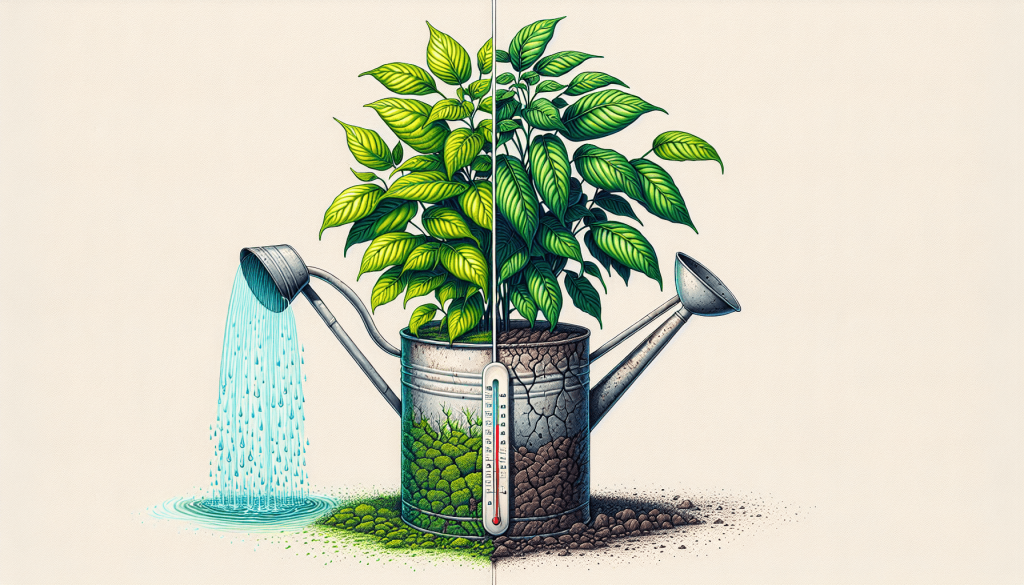
Tips to Avoid Overwatering
Don’t Follow a Strict Schedule
Avoid following a rigid watering schedule. Instead, water your plants based on their individual needs. Factors like temperature, humidity, and soil moisture levels can fluctuate, and as a result, your plants’ watering needs can change. Regularly assess your plants and adjust your watering routine accordingly.
Use Well-Draining Soil
To prevent overwatering, ensure that your plants are potted in well-draining soil. This will allow excess water to flow freely through the soil, helping to prevent waterlogging and root rot. Consider using a mix that includes ingredients like perlite or vermiculite, which enhance drainage and aeration.
Choose the Right Pot
Select pots with drainage holes to promote proper water drainage. Additionally, consider the size of the pot in relation to the plant’s root system. Pots that are too large can lead to excess moisture retention, while pots that are too small may not hold enough soil to provide sufficient water to the plant. Finding the right pot size for your plants is crucial in maintaining proper moisture levels.
Monitor Soil Moisture
Regularly check the moisture levels of the soil by using your finger or a moisture meter. This will help you determine when it’s time to water and when the soil is still sufficiently moist. By keeping a close eye on the soil moisture, you can prevent overwatering and adjust your watering routine as needed.
Adjust Watering Based on Season
Seasonal changes can have a significant impact on your plants’ water requirements. During the warmer months, plants generally require more water due to increased evaporation rates. Adjust your watering frequency and amount accordingly to prevent overwatering during periods of high heat and humidity.
Tips to Avoid Underwatering
Establish a Watering Routine
Set up a consistent watering routine to ensure your plants receive sufficient water on a regular basis. This helps prevent underwatering by providing a reliable supply of moisture to the roots. However, be mindful of the individual needs of each plant and adjust the watering frequency as necessary.
Don’t Rely on Rainfall Alone
While rainfall can provide a source of water for your plants, it is often insufficient to meet their needs fully. Depending on your climate and the amount of rainfall you receive, supplemental watering may be necessary to keep your plants adequately hydrated. Be mindful of weather conditions and monitor soil moisture to determine when additional watering is required.
Mulch to Retain Moisture
Adding a layer of organic mulch around your plants can help retain moisture in the soil by reducing evaporation. Mulch acts as a barrier, preventing water from escaping the soil surface and keeping the root zone moist for longer periods. This can be particularly beneficial during dry spells and hot weather when water loss is more pronounced.
Group Plants with Similar Watering Needs
Grouping together plants with similar watering requirements can help ensure that their hydration needs are met more effectively. This allows you to water them as a cluster, addressing their specific needs collectively. By organizing plants based on their moisture needs, you can minimize the risk of underwatering or overwatering specific plants.
Monitor Soil Moisture
Regularly check the moisture level of the soil to determine when your plants need watering. Stick your finger into the soil and if it feels dry at the depth of an inch, it’s time to water. By staying vigilant and monitoring soil moisture levels, you can prevent underwatering and provide the necessary amount of water to your plants.
Rescuing Overwatered Plants
Assess Root Health
When rescuing an overwatered plant, it’s essential to assess the health of its roots. Gently remove the plant from its pot and inspect the roots for any signs of decay or root rot. Healthy roots should be firm and white, while roots affected by overwatering may appear mushy, brown, or black. Trim away any damaged or rotten roots before repotting the plant.
Improve Drainage
To remedy overwatering, improve the drainage of the soil. Check that the pot has adequate drainage holes and consider adding a layer of gravel or small rocks at the bottom to promote better water flow. Repot the plant using well-draining soil or add perlite or vermiculite to the existing soil mix to enhance its drainage capabilities.
Reduce Watering Frequency
To allow the plant to recover from overwatering, reduce the frequency of watering. Allow the soil to dry out partially between waterings to prevent further waterlogging and root damage. It’s crucial to find the right balance and avoid both overwatering and underwatering until the plant has fully recovered.
Trim Affected Leaves
If your plant has developed yellow or brown leaves due to overwatering, trim away the damaged foliage. This will not only improve the plant’s aesthetic appeal but also redirect its energy towards new growth. Use clean and sharp scissors or pruning shears to make clean cuts just above the base of the affected leaves.
Repot the Plant
If the roots of your overwatered plant are severely damaged or if the current pot does not have proper drainage, it may be necessary to repot the plant. Choose a new pot with drainage holes that is appropriate in size for the plant’s root system. Repot the plant using fresh, well-draining soil, and ensure that the roots are gently spread out before covering them with soil.
Reviving Underwatered Plants
Slowly Rehydrate the Plant
Reviving an underwatered plant requires a gradual approach to prevent shock to its system. Begin by watering the plant lightly and allowing the water to be absorbed. After a short period, water the plant again and gradually increase the amount over several sessions. This slow rehydration allows the plant to recover without overwhelming its roots.
Water Deeply and Thoroughly
When watering underwatered plants, it’s crucial to ensure that water reaches the entire root zone. Water the plant thoroughly until excess moisture starts draining from the bottom of the pot. This helps rehydrate the roots and promotes new growth. However, it’s important to avoid overwatering, as underwatered plants typically have weakened root systems that may be more susceptible to root rot.
Mist the Leaves
Misting the leaves of underwatered plants can provide temporary relief and help increase humidity levels. Use a spray bottle filled with clean water to lightly mist the leaves, ensuring thorough coverage. This can alleviate dehydration symptoms and provide a boost in moisture until the plant’s roots can adequately absorb water from the soil.
Prune Dead or Damaged Parts
Underwatered plants may develop dead or damaged foliage due to water stress. Pruning away these parts helps redirect the plant’s energy towards new growth and enhances its overall appearance. Use clean and sharp pruning shears to make precise cuts just above healthy nodes or leaf junctions.
Provide Proper Care
To revive an underwatered plant, provide it with the proper care it needs moving forward. This includes maintaining a consistent watering routine, ensuring that the soil is kept evenly moist but not waterlogged. Additionally, monitor the plant for signs of underwatering or overwatering and adjust its care accordingly. Regularly fertilize and provide the necessary light conditions to promote healthy growth.
Preventing Watering Issues
Observe Plant Behavior
Regular observation of your plants is key to identifying watering issues before they become severe. Pay attention to the appearance and behavior of your plants. Look for any changes in leaf color or texture, wilting, or slowed growth. By familiarizing yourself with the signs of overwatering and underwatering, you can address any problems promptly.
Use Moisture Meters or Probes
Moisture meters or probes are helpful tools that can provide accurate measurements of soil moisture. Insert the probe into the soil at different locations to gauge its moisture content. This eliminates the guesswork and allows you to pinpoint when your plants need watering or when the soil is still adequately moist.
Learn from Experience
Experience is a valuable teacher when it comes to plant care. Take note of how your plants respond to different watering practices and adjust your techniques accordingly. As you become more familiar with the needs of your plants, you’ll develop a better understanding of how to maintain optimal moisture levels and prevent watering issues.
Seek Professional Advice
If you’re unsure about how to properly water your plants or if you’ve been facing recurring watering issues, consider seeking professional advice. Local garden centers, horticulturists, or plant experts can provide valuable guidance tailored to your specific plant varieties and growing conditions. Their expertise can help you make informed decisions and improve your plant care practices.
Follow Plant-Specific Guidelines
Each plant species has its own unique requirements for water, light, and care. Research the specific guidelines for each of your plants to ensure you are meeting their individual needs. Some plants prefer consistently moist soil, while others thrive in drier conditions. By following plant-specific instructions, you can provide the best care for your plants and prevent watering issues.
Conclusion
Maintaining the right balance of water for your plants is crucial for their overall health and well-being. By understanding the signs of overwatering and underwatering, as well as the factors that influence watering needs, you can provide optimal care for your plants. Remember to regularly monitor soil moisture, adjust watering techniques based on the seasons, and establish a watering routine that suits the needs of your plants. By following these guidelines and implementing the tips provided, you can become a responsible plant parent and keep your plants healthy and thriving.


